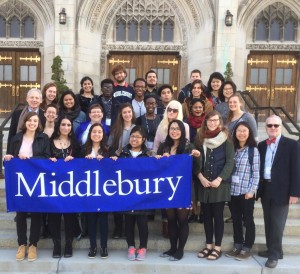Chicago native Amari Tevell Simpson ’16 (Psychology, Global Health, & Education Studies) wrote this piece on Tuesday:
Today was our busiest day yet. It almost seemed like we were pulled from place to place, but I will do my best not to skimp on the details of today’s adventures.
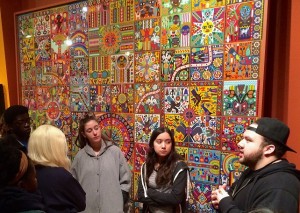 Our day started with a visit to the National Museum of Mexican Art in the Pilsen neighborhood of the city, which showcased Mexican art that challenges viewers to think about identity, cultural history, legends, revolutions, and more. The role of art has done so much to sustain culture for Mexican Americans faced with the everyday challenges of living in the US, so that many of us left thinking about how identities operate in promoting resistance against (or the acceptance of) dominant culture.
Our day started with a visit to the National Museum of Mexican Art in the Pilsen neighborhood of the city, which showcased Mexican art that challenges viewers to think about identity, cultural history, legends, revolutions, and more. The role of art has done so much to sustain culture for Mexican Americans faced with the everyday challenges of living in the US, so that many of us left thinking about how identities operate in promoting resistance against (or the acceptance of) dominant culture.
Following our visit, we sat down outside the museum to some very warm tamales and champurrado. There we bonded over the shared pleasure and enjoyment of food and company before driving out of the Pilsen 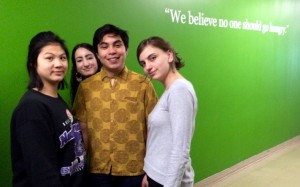 neighborhood to the Greater Chicago Food Depository on the city’s West Side. The work of the Food Depository, in general, serves to provide sustenance to those in Cook County who may not be able to provide for themselves or loved ones. Site workers shared that 1 in 5 people in the region go hungry, coming from all walks of life: the young, old, veterans, college students, and others. However, our volunteer work was unique on this particular day because we packaged materials in preparation for students who may not receive meals on the day that Chicago Teachers Union strikes, April 1st. Our role was to package bread and pop tarts for the three hours we volunteered for the day. Because our no. 1 goal was to have fun, most of us felt rewarded during the time we spent there and rewarded by the chance to help in anyway we could. With the combined efforts of all of the people volunteering that day, we prepared over 11,000 meals to be distributed to students on Friday when there would be no school.
neighborhood to the Greater Chicago Food Depository on the city’s West Side. The work of the Food Depository, in general, serves to provide sustenance to those in Cook County who may not be able to provide for themselves or loved ones. Site workers shared that 1 in 5 people in the region go hungry, coming from all walks of life: the young, old, veterans, college students, and others. However, our volunteer work was unique on this particular day because we packaged materials in preparation for students who may not receive meals on the day that Chicago Teachers Union strikes, April 1st. Our role was to package bread and pop tarts for the three hours we volunteered for the day. Because our no. 1 goal was to have fun, most of us felt rewarded during the time we spent there and rewarded by the chance to help in anyway we could. With the combined efforts of all of the people volunteering that day, we prepared over 11,000 meals to be distributed to students on Friday when there would be no school.
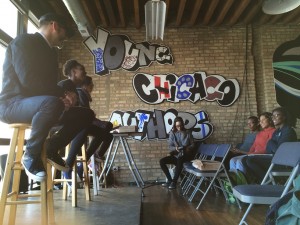 Finally, our day concluded with a trip to the Young Chicago Authors location in the Wicker Park neighborhood. We learned that young adults from all over the Chicagoland come to the Wicker Park location to perform and share their art—the same individuals who are very much connected to the activism that occurs in Chicago. Whether it’s dancing, singing, rapping, verging, or any other form of art, Young Chicago Authors provides a family-like atmosphere for everyone there. For this event, we started off by critically evaluating some poems and lyrics. Then we created our own work-shopped poems based, which were based on general theme related to labeling and social identity. Many people in the crowd shared their own work-shopped pieces, including Rabbi Schiffer. Afterwards during open-mic, various people from the audience shared their deeply personal and beautiful pieces related to faith, religion, family, the American Dream, queerness, sexual violence, their own identity, shootings in Chicago, and more. (Nia Robinson ’19 read a poem about her life as a person of color at Middlebury.) This event unapologetically revealed all facets of human life. The work that these young adults are doing is inspirational and invigorating for anyone interested in continued social justice and change.
Finally, our day concluded with a trip to the Young Chicago Authors location in the Wicker Park neighborhood. We learned that young adults from all over the Chicagoland come to the Wicker Park location to perform and share their art—the same individuals who are very much connected to the activism that occurs in Chicago. Whether it’s dancing, singing, rapping, verging, or any other form of art, Young Chicago Authors provides a family-like atmosphere for everyone there. For this event, we started off by critically evaluating some poems and lyrics. Then we created our own work-shopped poems based, which were based on general theme related to labeling and social identity. Many people in the crowd shared their own work-shopped pieces, including Rabbi Schiffer. Afterwards during open-mic, various people from the audience shared their deeply personal and beautiful pieces related to faith, religion, family, the American Dream, queerness, sexual violence, their own identity, shootings in Chicago, and more. (Nia Robinson ’19 read a poem about her life as a person of color at Middlebury.) This event unapologetically revealed all facets of human life. The work that these young adults are doing is inspirational and invigorating for anyone interested in continued social justice and change.
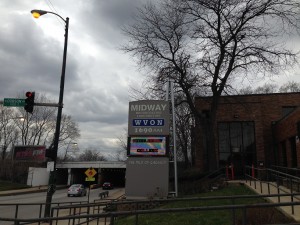 (submitted by Larry Yarbrough)
(submitted by Larry Yarbrough)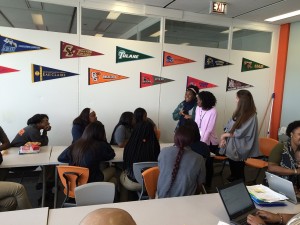 After touring the facilities with two juniors, we met in small groups with 80 Butler students who are beginning to think and plan for the next steps in their education. Our six Chicago students divided themselves among the groups, joined by other Middlebury students to talk about transition to college and college life. It was not all pitching a line. The conversations dealt with real challenges students from schools like Butler face when attending elite colleges like Middlebury. Butler students had tough questions; our students were impressed—and a little unsettled.
After touring the facilities with two juniors, we met in small groups with 80 Butler students who are beginning to think and plan for the next steps in their education. Our six Chicago students divided themselves among the groups, joined by other Middlebury students to talk about transition to college and college life. It was not all pitching a line. The conversations dealt with real challenges students from schools like Butler face when attending elite colleges like Middlebury. Butler students had tough questions; our students were impressed—and a little unsettled.